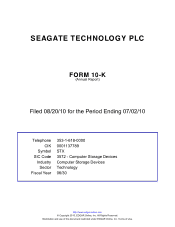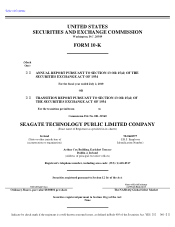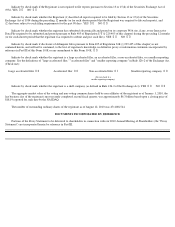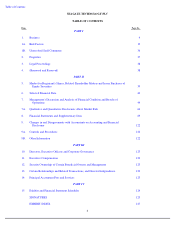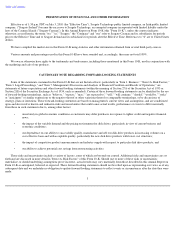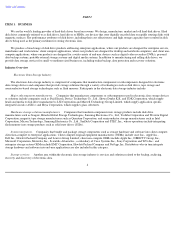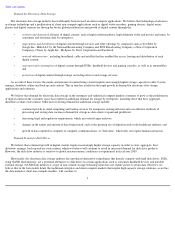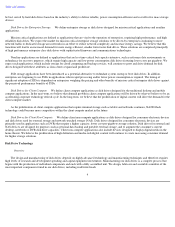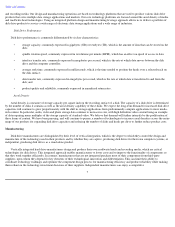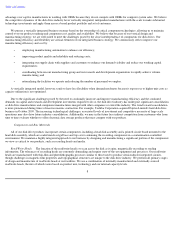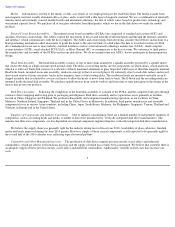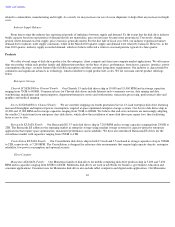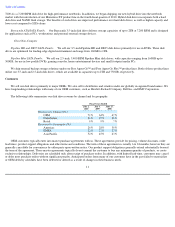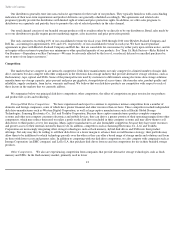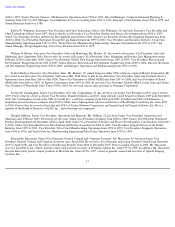Seagate 2009 Annual Report Download - page 9
Download and view the complete annual report
Please find page 9 of the 2009 Seagate annual report below. You can navigate through the pages in the report by either clicking on the pages listed below, or by using the keyword search tool below to find specific information within the annual report.
Table of Contents
and recording media. Our design and manufacturing operations are based on technology platforms that are used to produce various disk drive
products that serve multiple data storage applications and markets. Our core technology platforms are focused around the areal density of media
and read/write head technologies. Using an integrated platform design and manufacturing leverage approach allows us to deliver a portfolio of
disk drive products to service a wide range of electronic data storage applications and a wide range of industries.
Disk Drive Performance
Disk drive performance is commonly differentiated by six key characteristics:
• storage capacity, commonly expressed in gigabytes (GB) or terabytes (TB), which is the amount of data that can be stored on the
disk;
• spindle rotation speed, commonly expressed in revolutions per minute (RPM), which has an effect on speed of access to data;
• interface transfer rate, commonly expressed in megabytes per second, which is the rate at which data moves between the disk
drive and the computer controller;
•
average seek time, commonly expressed in milliseconds, which is the time needed to position the heads over a selected track on
the disk surface;
•
data transfer rate, commonly expressed in megabytes per second, which is the rate at which data is transferred to and from the
disk; and
• product quality and reliability, commonly expressed in annualized return rates.
Areal Density
Areal density is a measure of storage capacity per square inch on the recording surface of a disk. The capacity of a disk drive is determined
by the number of disks it contains as well as the areal density capability of these disks. We expect the long-term demand for increased disk drive
capacities will continue to grow proportionately with the shift in storage applications from predominantly compute applications to more media-
rich content. In particular, audio, video and photo storage data continue to increase in size, with high definition video content being an example
of data requiring many multiples of the storage capacity of standard video. We believe that demand will further intensify by the proliferation of
these forms of content. We have been pursuing, and will continue to pursue, a number of technologies to increase areal densities across the entire
range of our products for expanding disk drive capacities and reducing the number of disks and heads per drive to further reduce product costs.
Manufacturing
Disk drive manufacturers are distinguished by their level of vertical integration, which is the degree to which they control the design and
manufacture of the technology used in their products and by whether they are captive, producing disk drives for their own computer systems, or
independent, producing disk drives as a stand-alone product.
Vertically integrated hard drive manufacturers design and produce their own read/write heads and recording media, which are critical
technologies for disk drives. This integrated approach enables manufacturers to lower costs and to improve the functionality of components so
that they work together efficiently. In contrast, manufacturers that are not integrated purchase most of their components from third-party
suppliers, upon whom they depend for key elements of their technological innovation and differentiation. This can limit their ability to
coordinate technology roadmaps and optimize the component design process for manufacturing efficiency and product reliability while making
them reliant on the technology investment decisions of their suppliers. Independent manufacturers can enjoy a competitive
7

